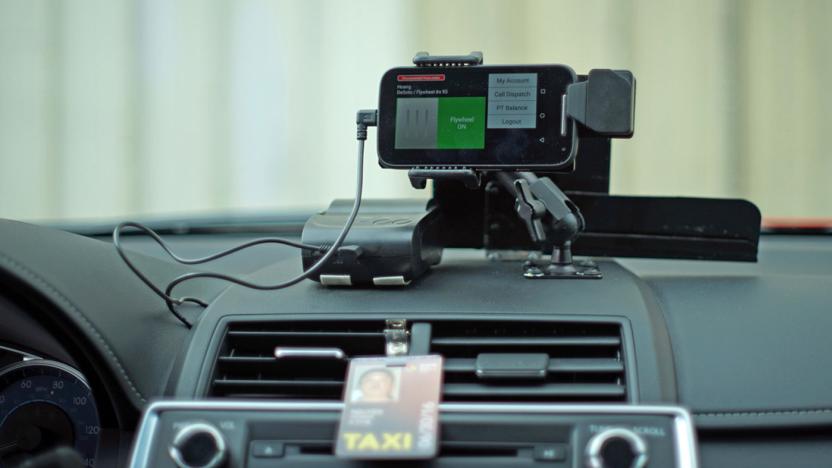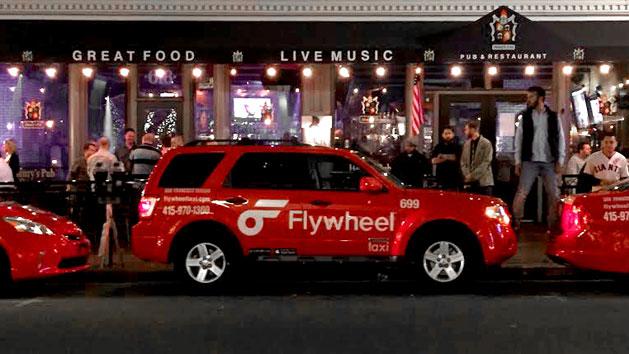Flywheel
Latest

Uber will soon offer taxi rides in San Francisco
The ride-hailing giant has inked a deal with Yellow Cab SF and Flywheel.

If you bought Flywheel's home bike, you can trade it in for a free Peloton
One of Peloton's biggest competitors, Flywheel Sports, announced today that it is shutting down its online classes. The company sent an email informing its users that it would stop its Flywheel At Home service effective March 27th 2020. The bikes can still be used of course, but without the live and on-demand coaching, which makes them not much better than ordinary stationary bikes. Peloton, however, is offering a deal where Flywheel customers can turn in their bikes in exchange for a "like-new" Peloton bike at no cost to them, though they'd still have to pay Peloton's monthly subscription fee.

Block-like robots could assemble into emergency staircases
Next to Boston Dynamics' leaping humanoids, the dice-like M-Block robots from MIT might not look very cool. Considering their lack of limbs, though, the latest versions can perform some impressive tricks like jumping, climbing and assembling into larger structures, Big Hero 6 style. Those skills could one day help them assemble themselves into a staircase to rescue survivors trapped in a building, or be used as real-world Minecraft blocks.

Best Buy will dedicate store space to 'smart' gym equipment
Best Buy thinks it might have another way to remain relevant in the face of online shopping: diving head-first into smart fitness technology that often benefits from hands-on time. The big-box retailer has launched a fitness initiative that includes selling a variety of connected fitness equipment (more on that shortly) and, importantly, the retail commitment to back that up. Over 100 stores will have dedicated fitness spaces by the end of 2019, with in-store and home visitation staff receiving "special training" to help you understand the hardware.

Uber faces $5 million suit from San Francisco's oldest cab company
Another party is suing Uber over the ride-hailing service's business practices. This time it's San Francisco's Flywheel, the taxi company formerly known as DeSoto Cab, also known as SF's oldest taxi company. To the tune of a $5 million-plus federal suit, Flywheel alleges that since UberX came to be in 2012, the city's taxi industry has lost 65 percent of its riders and 30 percent of its drivers, according to SF Gate.

Flywheel's phone-based taxi meter arrives in NYC
Flywheel is giving taxis in New York City the modern touch. The company is bringing its software meter and app-based hailing system to the Big Apple after its initial release in a handful of cities last year. TaxiOS puts a cab's navigation, payment, meter and dispatch system on a single phone. It can automatically calculate fares, including tolls, split the total amount between passengers, accept credit card and cash payments and email receipts to customers. Plus, it will allow taxis in the city to accept app payments made through Flywheel's Uber-like ride-hailing app even if you flag them down in the street.

California approves Flywheel's attempt at modernizing taxis
Flywheel's plan to bring taxis into the 21st century just got the all clear. California regulators have approved TaxiOS, the smartphone-based Flywheel platform that lets cabbies ditch their clunky conventional meters in favor of GPS and other modern luxuries. While the company had been limited to trying out its software in just 70 San Francisco cabs, this lets it expand to virtually everywhere in the state. All 200-plus Flywheel-badged San Francisco cabs will be using TaxiOS by February, and it won't be surprising if its other Californian coverage areas (currently Los Angeles, Sacramento and San Diego) follow suit.

Flywheel gives taxi drivers an Uber-like app of their own
Flywheel has helped drag taxis into the modern era through app-based hailing. However, that modernization usually stops in the cab itself -- your driver's gear is antiquated next to the phone-based tech in a Lyft or Uber car. Taxis are about to catch up, though. Flywheel has launched TaxiOS, a platform that replaces the dispatch, meter, navigation and payment systems with phone-based software. It not only streamlines the overall experience for both you and the driver (no matter how you're paying), but marks the first instance of GPS-based metering in licensed taxis. In theory, you're getting both a more accurate fare and fewer rude surprises.

Flywheel wants you to skip the wait for app-friendly taxis
As convenient as ridesharing and app-based taxi services can be, you still have to wait for your lift to show up. Wouldn't it be nice to hop into the first available taxi and then pay through an app? Flywheel is trying just that. Its new Pay by Flywheel service lets you hail a taxi and pay after you're on your way -- the app uses your phone's motion sensors to tell when you're in mid-ride. It's theoretically just as speedy as flagging down a conventional taxi, but saves you the hassle of fumbling with your wallet at the very end. The option is available today in every Flywheel area, including the just-added city of Portland.

Flywheel has an answer to Uber's NYE surge pricing: $10 rides
Getting to and from your New Year's shindig can be an expensive hassle, even if you're not driving: you're either competing for a conventional (and thus costly) taxi or bracing yourself for the surge pricing of ridesharing services like Uber. Flywheel may have a relatively cheap solution for that night on the town, though. The app-based taxi service is running a promotion that charges you a flat $10 to get to or from your New Year's party in Sacramento, San Diego, San Francisco or Seattle. The only stipulations for this low fare are that you travel between 8PM and 3AM, and that your ride wouldn't normally cost more than $50. You may not get from one end of the city to the other on the cheap, then, but the deal could save you from starting 2015 with a gigantic credit card bill.

NYC taxis may have to wait longer for app hails
Fans of taxi-finder apps like Uber, Hailo and FlyWheel may have to wait a bit longer before they can raise their iThumbs to flag down yellow cabs in the US' busiest urban area. Per the WSJ, a lawsuit by livery cab drivers may block a rule change that would allow app-based hailing in NYC. While iPhone apps to summon a taxi or "black car" ride are popular in other cities, New York's slightly Byzantine rules governing for-hire cars have made it challenging for these apps to make inroads in the Big Apple. The city's iconic yellow cabs can respond to street hails, but for many years have not been allowed to take phone reservations or centralized dispatch. The lawsuit contends that an e-hail is equivalent to dispatching, and that these apps will encroach upon the for-hire car market. The chairman of the city's Taxi and Limousine Commission, former city council member David Yassky, didn't mince words in his statement responding to the legal maneuverings. "This suit seeks to keep the taxi industry and New Yorkers in the dark ages... Next thing, they'll be suing restaurants to go back to wood-burning stoves. Our rules allow for e-hail now, and the only question is, do we embrace these new services and ensure that consumer protections are in place, or listen to obstructionists and watch e-hail apps proliferate without any regulatory input." Back in December, the TLC approved a year-long pilot test of app-based hailing for yellow taxis. The earliest possible start date for that test was February 15, but now it's possible it may take even longer for the service to kick off. An earlier test by Uber had to be canceled due to too few participating cabs and too much demand, not to mention that the TLC hadn't yet figured out how e-hailing was going to work in the city. Meanwhile, livery cabs, car services and corporate cars can indeed be dispatched by phone and by app -- Uber's app already covers most of NYC's business district -- but they aren't allowed to pick up arbitrary passengers on the street (although many flout the rules). On recent trips to Chicago and San Francisco, I was pleasantly surprised by how effective Uber's cab service was, with a ride showing up promptly in almost all cases (one attempt at rush hour in SF's downtown financial district didn't pan out). I would certainly take advantage of an e-hail tool in NYC, assuming the interested parties ever sort out their disputes. [via Transportation Nation and Crain's New York]

Flybus consortium puts the brakes on energy waste, throws it back to the asphalt
For anyone who's logged time city bus surfing, you know there's a heckuva lot of power in those screechy stops and starts. So, it stands to reason there'd be a way to harness that kinetic energy and shuffle it right back to the auto, itself. Well, that's exactly what the Flybus consortium aims to do with a prototype that uses a Ricardo Kinergy flywheel to store energy created from braking, and redistribute it via a continuously variable transmission. The hybrid setup is purportedly much cheaper to produce than current, pricier EV rigs, and would also go a long way towards reducing fuel costs for commercial vehicles. Gearheads eager for a peek at the group's design can get a look-see when it's shown off this month at the Low Carbon Vehicle event in the UK. For everyone else, there are the source links below.

Beacon Power completing construction of 20-megawatt flywheel plant, the world's largest
Remember Beacon Power, that startup using 2,800-pound flywheels to cut noxious emissions? Well, three years later, the company is wrapping up construction of its first plant, a 20-megawatt operation that just happens to be the world's largest. The Stephentown, NY facility is home to 200 of these flywheels, which store and output energy as needed, essentially matching the power supply with the demands of the grid. The result, the company promises, is reduced energy waste and stable electrical frequencies hovering around 60Hz. And while the plant's already up and running at 18 megawatts, it won't be until later this month that Beacon finishes building it out so that it reaches its full capacity. Full PR and champagne-popping celebration plans after the break. %Gallery-125247%

Visualized: Porsche's GT3 R Hybrid has its very own boost button
Sure, it may seem like any old Formula 1 steering wheel, but take a closer look. See that big red button sitting on the left side, just begging to be pressed? That, friends, would be a boost button, capable of giving this Porsche 911 GT3 R Hybrid racer an extra burst of acceleration. Unlike most battery powered hybrids, both the 911 GT3 R and the 918 RSR run on an inertial flywheel that's spun by the momentum generated whenever the car brakes. All it takes is one tap of the boost button, however, for that momentum to be instantly converted into a potent jolt of KITT-like horsepower. We still don't really know what we'd do with all the other buttons, but we definitely know which one we'd keep our thumb on.

Porsche gives 911 GT3 R hybrid more power, less weight -- swears it wasn't fat or anything
There are two ways to make a car go faster, add power or subtract weight, and Porsche has done a little bit of both to its new 911 GT3 R hybrid racer in preparation for this year's Nürburgring 24-hour race. Porsche took last year's version, put it on a 50kg diet, and bumped the output of each of the car's two KERS-powered front-wheel electric motors by 21hp (giving drivers 202 'lectric horses and 480 of the ICE variety for a pavement-melting 682hp total). The boys from Stuttgart hope the Jenny Craig routine will improve performance, fuel economy, and the car's chances of winning the endurance event in June. The hybrid-drive technology -- originally sourced from Williams' F1 cars -- made an appearance in the firm's 918 RSR hybrid and is largely unchanged from the 2010 model. Unfortunately, this is a racing-only situation, what with the KERS flywheel riding shotgun, but we're sure one of the hundreds of other technologically-inclined 911 variants will sate your need for speed.

Veritas RSIII Roadster Hybrid melds plug-in tech with 600HP
It isn't exactly the hottest hybrid we've ever seen, Porsche's ludicrous 918 RSR still takes that crown, but the Veritas RSIII Roadster Hybrid is certainly no wheezy commuter. It's a tiny, open-topped racer that features a 507HP V10 from BMW that's been paired with a 105kW motor to spin the front wheels. It's much the same arrangement of the Porsche, again relying on a KERS flywheel to generate electricity that's stored in a Li-ion battery pack, which can also be charged separately. The car can actually limp around for up to 31 miles powered by just that front motor, but when both sources of thrust are called upon the sled gets to 62MPH in 3.1 seconds, as fast as a 911 Turbo S, and it'll keep on going until the speedo hits 205 -- or the car hits something immovable. No word on price or availability, but there is a version with a roof coming this summer, and a fully-electric model due in 2013.

Porsche unveils 918 RSR, the 767hp hybrid
Prius this ain't. Take a gander at Porsche's 918 RSR, which just rolled onto the company's stage at the 2011 North American International Auto Show. It has a 563hp traditional gasoline engine mounted amidships, with a pair of electric motors powering the front wheels that bring the total power up to a whopping 767. The electric motors are not powered by a set of batteries, as in a traditional hybrid, rather they take their power from an inertial flywheel mounted where the passenger seat would be on a road car and spinning at up to 36,000rpm. That's spun up by momentum when the car brakes and, when the driver hits a button, that momentum is converted to give an acceleratory boost. That's the same setup as the 911 GT3 RSR Hybrid, which ran reasonably successfully last year. Its styling is obviously an extension of the 918 Spyder, with a number of cues taken from the incredibly successful Porsche 917 racer of the early '70s (dig the endplates that look like the 917's iconic fins). At this point Porsche hasn't indicated when this car will make its debut on the track, nor in which classes it will run, but one thing's for clear: this isn't for the road. So, we're a bit disappointed we still haven't any firm details on a production, street 918 -- not that we could have afforded it anyway. %Gallery-113625% %Gallery-113626%

Beacon Power hopes to juggle electricity more efficiently
Bay State startup Beacon Power isn't just another wind / solar / hydroelectric outfit. Oh no, this firm is more concerned with reducing the emissions from the energy plants we already have in place. Put simply, the company's 2,800-pound flywheels are used to store and output energy when needed, a service Beacon's CEO is dubbing "frequency regulation." Essentially, said devices will "match power supply to the grid with power demand from the grid," which curbs energy waste and keeps loads in perfect balance. As it stands, the only disclosed expansion plans include more of Massachusetts and New Hampshire, but if it can rope in enough customers, we reckon the sky's the limit. Video after the jump.[Thanks, John]

GyroBike flywheel helps bicycles self-steady
Besides learning to use the toilet properly, the ability to ride a bicycle is one of the most important early-childhood accomplishments, but unfortunately, the current use of training wheels for practice does little to prepare kids for life on two wheels. Well a start-up using technology developed at Dartmouth College is aiming to eliminate the rolling crutches that are training wheels, and replace them with a gyroscopic flywheel that attaches to the front wheel and helps a bike steady itself whenever the rider loses his/her balance. Expected to retail for around $40 when it hits the market, the GyroBike by the company of the same name works by spinning in conjunction with the wheel it's attached to, using natural physical properties to turn the handlebars towards the direction of an impending fall. GyroBike also claims to be in talks with the top six manufacturers of kids' bikes, so you may soon be able to buy a model with this technology built-in instead of retrofitting one you already own.[Via Cnet]











